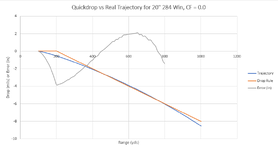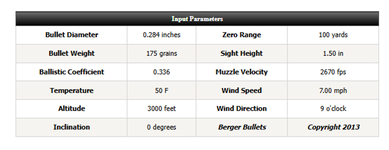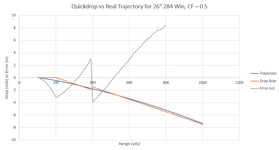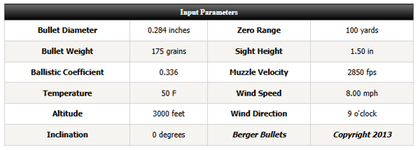Here's my simple description of how to use Quickdrop:
- For a "normal" gun, for all ranges between 200 and 800yds, Quickdrop = yards/100 - 2
- Below 200, just hold dead on
- Using this rule, you will be within ~4" from 0-800yds in about 1 second with no phone/app/dope card. For most of this distance you are actually much closer.
- For a "better" gun, same as above, except beyond 400yds, Quickdrop = yards/100 - 2 - correction factor
- For a "worse" gun, Quickdrop = yards/100 - 2 + correction
- What's also cool is you can pick up any gun/cartridge, estimate what level of performance it is on this simple scale, and get really close really fast.
Simple rule of thumb for correction is +/-0.5, but you can tailor it to your gun to reduce error if you want to.
GoodGun, average gun and Bad gun are better describers with less subjective overlap for good, avg, bad brackets.
Good gun:
.3-.6 G1 BC, 2800-3000 fps
Average gun:
.3-.6 G1 BC, 2600-2800 fps
Bad gun:
.3-.6G1 BC, 2400-2600 fps
Quick drop use Average Gun as BASE GUN, which is range-2.
450yds -2= 2.5 Mils dial up
800yds -2= 6Mils dial up
279yds -2= .8 Mils dial up
Beyond 7-800 QD starts to diverge depending on your rifle and conditions.
From there, a rifle is BASE(-2) + or - .5
Good Gun, range -2 -.5Mil
Bad Gun, range -2 +.5Mil
This sounds like extra mental math but in function it's not.
Good gun:
450yds -2 =2.5 Mils -.5
Dial 2.5 and back .5 to 2Mils or straight to 2 Mils once you've mastered it.
Bad gun:
450yds -2 =2.5 Mils +.5
Dial 2.5 Mils, dial up another .5 to 3 Mils.
The reason it's taught that way is so Average Gun is the BASE you operate from, the system. Then you add or subtract from the base figure.
It sounds hard until you do it, it's easy once you adjust to operating this way. like anything. it becomes automatic.





